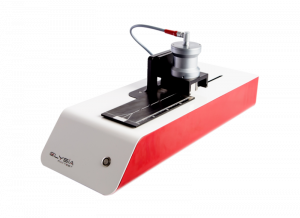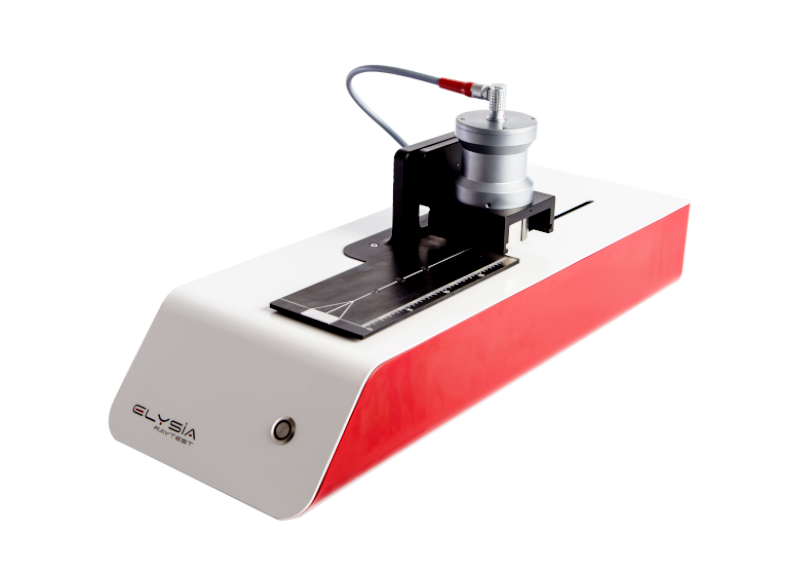miniGITA Single
- Radio TLC
Versatile & User-Friendly.

Features
- Radio Thin Layer Chromatography
- Basic spectrum scan
- Basic half life time confirmation
- Automatic identification of dosimeters
The miniGITA Single is the new version of the well know miniGITA Star. It is a versatile state-of-the-art radio TLC system. The new motor technology reduces considerably the running noise. A complete range of detector probes allow the measurement of nearly every isotope. It is designed for optimal use in nuclear medicine, SPECT or PET laboratories.
Simply exchange the detector and the collimators to get the best performance for every application. Our detectors work gas free, ensuring long life time and low maintenance costs. The high sensitivity combined to the moving sample table allows a very fast analysis, with an average canning time of less than 1 minute.
GxP features, spectrum scan capabilities and a basic half life time mode make the miniGITA Single a versatile system for your quality control lab. Outstanding detection capabilities, excellent signal-to-noise ratio and optimal signal resolution make the miniGITA Single the perfect workhorse for your lab.
DETECTORS
We have a complete line of new generation probes using different scintillator material and differen detection technologies. We propose systems with well-established PMT tubes as well as totally new digital detection technologies, ensuring the best detection for each application.
PROBE TYPES
miniGITA OFA (One-fits-all) probe
The ONE-FITS-ALL is based on our well-known V-Shaped BGO technology. The crystal allows the detection of SPECT and PET isotopes. The special V-shape gives best resolution without any loss of sensitivity. A broad range of collimators allows to adapt the probe to a large energy band. The detector has also a multichannel function and is suitable for basic spectrum scans.
miniGITA PET probe
The probe has been designed for use in a PET laboratory. The scintillator and the digital detector technology allow a very high resolution and a high sensitivity to positrons. High insensitivity to gamma radiation and an extremely high dynamic range ensure very low background noise to gamma irradiation and the possibility to handle high amounts of activity. These skills make the detector the right choice for every PET facility
miniGITA New Gen probe
As the OFA, the New Gen probe is based on a V-Shaped BGO probe ensuring best resolution with high sensitivity to SPECT and PET isotopes. The probe is using the new electronics with increased dynamic range allowing to use higher activities without signal saturation. A broad range of collimators allows to adapt the probe to a large energy band.
miniGITA 3SA probe
The miniGITA Self Shielded Spectrum Analysis probe has been designed to obtain an optimal spectrum analysis when paired with our TLC scanner. To eliminate background issues, the probe is self-shielded. As with all miniGITA probes, it uses the ECP and can be used in combination with several other Elysia instruments. The in-built high quality PMT is the best choice for spectrum analysis and nucleic identification.
miniGITA Alpha probe
The miniGITA Alpha probe has been designed to offer optimal Alpha Sensitivity when paired with our TLC scanner. The probe is based on ZnS(Tl) scintillator connected to a SiPM, combining a high efficiency for Alpha radiation and a Low Background for Beta and Gamma. As all miniGITA probes, it uses the ECP and can be used in combination with several other Elysia instruments.

COLLIMATORS
To avoid human mistakes and to obtain the best collimation, the miniGITA Single has tungsten collimators with an automatic recognition for GMP documentation.
miniGITA Single collimator: 0-60 keV
miniGITA Single collimator: 60-250 keV
miniGITA Single collimator: 250-450 keV
miniGITA Single collimator: > 450 keV
SOFTWARE
The miniGITA Single is directly controled with GINA software with a digital signal transfer according to GMP/GLP standards. Gina is also used to control to the radio-HPLC, the GC or the multichannel analyzer. This allows a faster adaptation and a short learning curve if you decide to use GINA for your QC systems
